

Flatbush says farewell to some significant faculty members
By Samantha Ryba Editor-in-Chief
As the school year comes to an end, the Yeshivah of Flatbush prepares to say farewell to a number of beloved faculty members, each of which have left a lasting impact on the school.
Ms. Talia Harcsztark, who served as the Chair of the Tanakh Department, will be making Aliyah this summer. She plans to take a teaching position at a girls’ high school in Jerusalem. “I am so grateful to be able to continue doing what I love in my favorite city,” she said. Ms. Harcsztark’s students and colleagues will miss her engaging classes and the way she encourages spiritual and academic growth in students. She will miss plenty of people, too: “People are irreplaceable and so I will really miss the special administration, faculty, and students at Flatbush who all taught me so much,” she said.
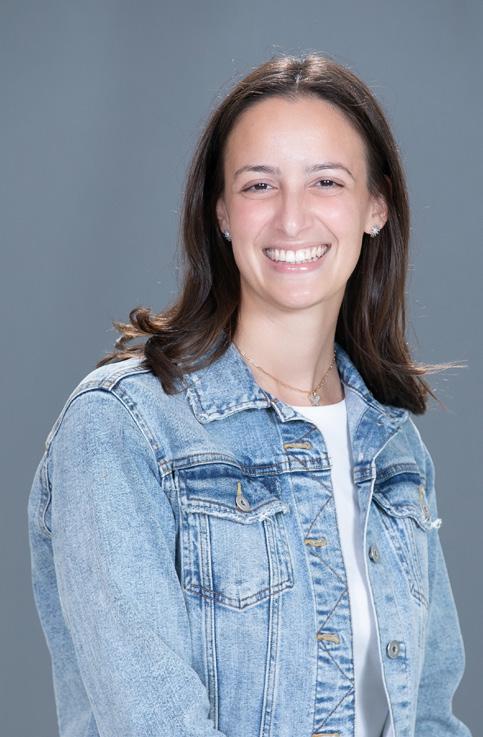
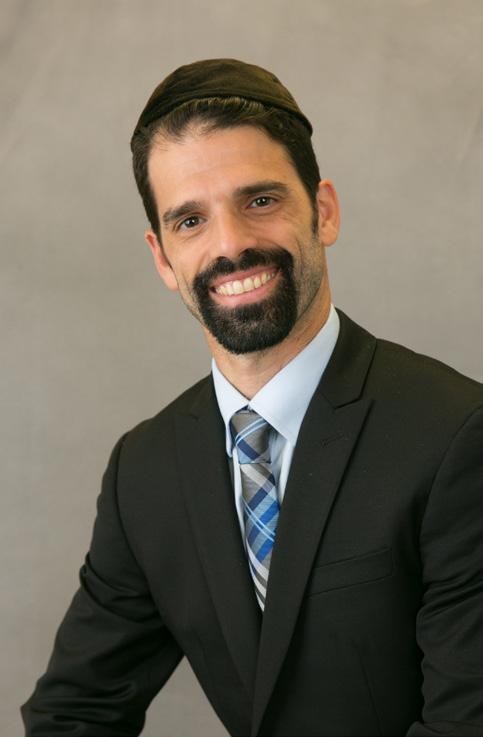
Rabbi Charles Safdieh, known for his humor and personal connections with students, has plans to take a dynamic role at Barkai Yeshivah High School, where he will be teaching and advising a variety of students and classes. “After teaching at my alma mater, Flatbush High School, for eight years, I felt it was time for a change,”
College Guidance takes sophs to visit schools
By Yvette Dweck Junior Editor
College Guidance took sophomores on college visits this year for the first time. Earlier this month, sophomores visited Barnard College, College of Staten Island, Queens College, and Fordham University. These colleges were hand-picked by the college guidance counselors for a multitude of reasons. Director of the department, Ms. Mottahedeh, explained that these colleges were chosen because they were “local options that allow students the flexibility to either commute from home or live on campus, [have] a wide variety of academic programs, rather than a narrow focus in one area, [and have] access to some form of Jewish life on campus.” These criteria were important to College Guidance because the goal of these trips was simply to give sophomores a glimpse into college life.
Torah: Page 2
Merle: Page 7
The sophomores absolutely loved the visits. Sophomore Celia Aini, who visited the College of Staten Island CUNY, said the tour was an “insightful and enjoyable experience. It helped me learn about what life would be like on campus and allowed me to hear from students at CSI.”
Current Barnard Sophomore and Hillel Yeshiva alumna Esther Cohen explained the benefits of visiting colleges in person and said, “there’s a lot of speculation and talk about Barnard right now, so I think it was very important for the sophomores to see student life for themselves and make decisions based on their own experiences instead of what they’re hearing.”
Flatbush alumna and current Barnard sophomore Frieda Catton explained that her campus visit in May of her junior year was the perfect time. “I think it was the right time to visit because I had spring and summer to think about early decision
continued on page 6
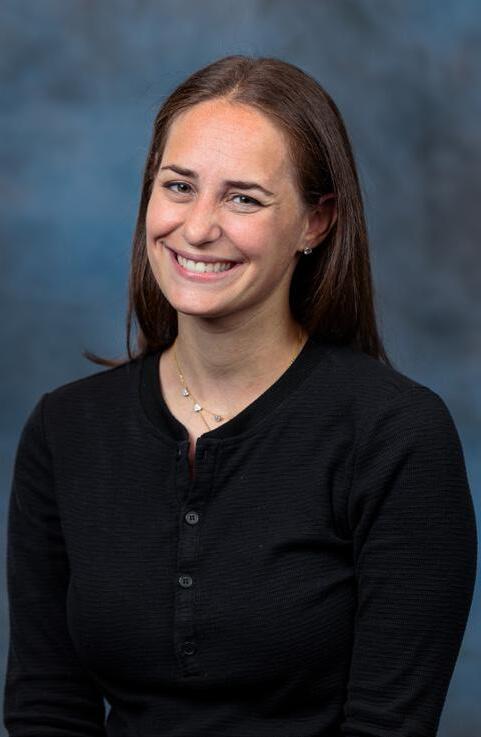
he shared. Rabbi Safdieh previously taught at Barkai and also sent his children there, making his return even more meaningful. While he is sure the move will be accompanied by a fair share of challenges, “there will definitely be many teachers and students that I will miss seeing every day.”
Rabbi Safdieh said he is looking forward
to the next chapter of his career. “With any transition, there’s a certain degree of uncertainty and excitement,” he said, “but I’m sure with G-d’s help it will go smoothly.”
Also joining Barkai is Ms. Shoshana Mayer, who will serve as Director of the Middle School Learning Center and a Middle School Guidance Counselor. “The role brings together everything I’ve trained for as a school psychologist,” she said, sharing her excitement for the leadership opportunity ahead. Ms. Mayer, who began her journey at Flatbush as a Guidance intern, said she will especially miss her students and the Guidance team, who she considered her work-family. “I’ll always be grateful to Flatbush and the wonderful experience they have provided me,” she concluded.
Other departing faculty members declined requests for interviews.
Mandatory physics for juniors ends rocky first year
By Viviane Baghdadi Contributing Writer
This year, a big change was made to the science curriculum: physics is now a mandatory class for all juniors and is no longer offered as an elective. The decision was made with college readiness in mind, as many colleges look for a well-rounded science education on applicants’ transcripts, one that includes physics alongside biology and chemistry.
In previous years, students were required to complete three science classes, but they had the flexibility to choose their third science class either during junior or senior year. The classes they were able to pick from included AP Biology, AP Chemistry, Nutrition, Environmental Science, and Physics.
Now, all juniors must take physics in order to meet graduation requirements. However, due to time constraints, the

course is not Regents-based. For nonhonors students, the class is offered on a regular level, but for honors classes, the course is divided into two: Honors Physics and AP Physics.
One of the biggest challenges in the program’s first year was the sudden midyear departure of the school’s only fulltime physics teacher, Mr. Tobias. However, even before that challenge came up, reactions to the new requirement were mixed.
Some students feel that the change is beneficial. “I’ve overall been enjoying the opportunity to learn physics this year. It’s been great to continue building on the foundation we’ve established in science over the past two years. Without the pressure of Regents, there’s more room for projects, making it much more enjoyable to learn in a less stressful environment,” said junior Albert Shamah.
Others, however, feel the requirement

A Student Publication of the Yeshivah of Flatbush Joel Braverman High School • 1609 Avenue J, Brooklyn, New York •
Ms. Harcsztark, Rabbi Safdieh, Ms. Mayer
Faculty Freshman: Mr. Jack Dweck
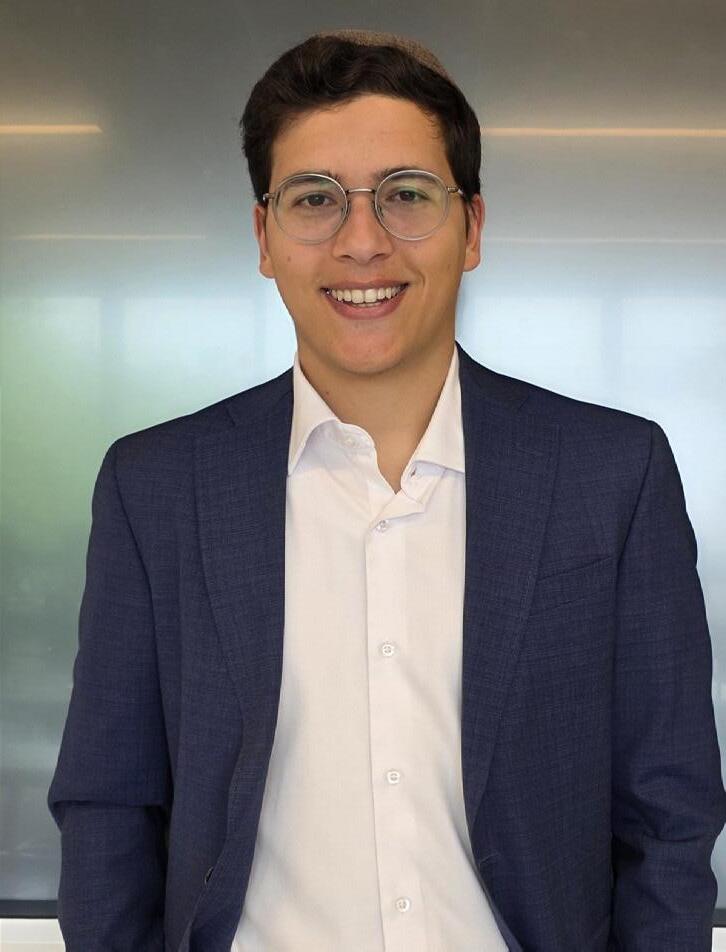
By Sylvia Saad Editor-in-Chief
The sophomores had five different history teachers in the course of six months before the administration finally found Mr. Jack Dweck.
Mr. Dweck graduated from Flatbush in 2019 before attending NYU for his undergraduate degree in political science. He currently attends Cardozo School of Law and will be graduating in May.
Although Mr. Dweck is still a law student and an intern at Fried Frank, a law firm where he will be working after graduation, his experience teaching left him wanting more. A few years ago, Mr. Dweck
taught art at Mill Basin High School to freshmen and sophomore girls and really enjoyed it. He has also been a Teacher’s Assistant for a writing class at Cardozo for two years and has been a crucial help to the Flatbush Mock Trial team. When Rabbi Beyda approached him to fill in as a teacher for sophomore world history, Mr. Dweck jumped at the chance to help out and gain more of a taste of the teaching experience. It was a full circle moment for Mr. Dweck to return to his Alma Mater as a teacher, and he had some time to spare until he graduated from law school.
Mr. Dweck’s students are grateful to have him as a teacher in the little time he’s had. “He’s a great teacher and really saved our year,” sophomore Ralph Serieh said.
Mr. Dweck has really enjoyed helping out with the Law Club at Flatbush in his time teaching. “I also enjoy seeing my brother, Joseph Dweck, during the day and interacting with all of the teachers I had in high school.”
Outside of the classroom, Mr. Dweck is a frequent sculptor and painter. He is a tennis and pickleball player and an avid follower of the Mets, Nets, and Islanders.
Although Mr. Dweck’s time will be short lived, as he will be working as a lawyer once he graduates, the impact he will leave will last far longer. He will hopefully continue to help the Mock Trial and Law Club in coming years.
Alum in Israel: Ezra Harari
By Ben Sutton Contributing Writer
Flatbush graduate Ezra Harari (HS ’24), is currently spending the year at Yeshivat Mosheret, located in Jerusalem. Harari called the decision to go to Israel for the year a “once in a lifetime opportunity.” Harari emphasized how in Moreshet, students learn in a Sephardic learning style which is the “way I want to learn.” He also mentioned that the school’s rabbis “are all experts” and “top guys in their field.” Lastly, it was important for Harari to be in a place where his friends were, and to overall have a great time while continuing his education.
A typical day at Moreshet looks something like this: first, Harari wakes up at around 7:45am for minyan. Following prayers, there is a short breakfast, until 9:45-10:15, during which morning electives take place. Students have the ability to study a variety of different texts such as the Hakdamot Shel Rombom, the text which Harari is currently studying. The day then consists of Morning Seder where all students study the same Gemera in groups, followed by a lunch break. During this break, students have the opportunity to go to the shuk, work out at the gym nearby, or even play basketball. At about 2:30, the boys pray Minha and go straight into the next seder, where every-
D’var Torah: Finding meaning in the desert
By Eddie Saff Contributing Writer
It’s no coincidence that Parashat Bamidbar is usually read the week preceding Shavuot. This indicates that there is a correlation between the Parashah, which discusses the census of the tribes, and the holiday, which celebrates Matan Torah.
It says in the very first Pasuk in Sefer Bamidbar,
and use them to their liking.
one is learning a different Halachic Text. The remainder of the day includes a few more periods of learning, a dinner break, and the prayer of Arbit. These periods help students connect with one another through learning and engaging conversation.
Harari explained how while being in Israel, he set many goals for himself, including building a good relationship with the Rabbis at Moreshet, and having fun by doing activities with friends outside of school. Harari’s favorite time of week is Shabbat. He added that there are two different kinds of Shabbats: an “In Shabbat” and an “Out Shabbat.” During an “In Shabbat” everyone stays in school singing pizmonim and learning in the Bet Midrash. For an “Out Shabbat,” students are invited to stay with different families throughout Israel, meeting new people and experiencing the different ways these families honor Shabbat.
Lastly, Harari explained that after living in Israel for a year, he’s realized he wants to make Israel more part of his identity by regularly visiting. He feels like he lives there full time and is not a tourist anymore, even improving his Hebrew language skills. Ezra is returning to America with meaningful and powerful experiences that he will take with him when he continues learning at NYU Stern next year.
“Hashem spoke to Moshe in the wilderness of Sinai . . .” (Bamidbar 1: 1). The Rabbis juxtapose the words “
A desert, however, is less relevant to most people than water and fire. Therefore, the Midrash teaches another lesson: one must make himself Hefker or ‘ownerless’ like a desert. He must run from the materialistic pleasures of the world in order to feel a true connection to the Torah. He must be humble and bare, as a desert. With this mindset, he will find true appreciation in the depth of the Torah and its great messages.
before Mincha. The Rabbi asked the man why he traveled to China just to learn. At first, the man was hesitant but then told his story.
fer, they explained that there was a low chance they would choose him.
and “
”, inferring a connection between them. Why, they ask, was the Torah given in the wilderness of Sinai of all places?
The Midrash (Bamidbar Rabbah 1: 7) states that there are three factors of Matan Torah: water, fire, and the desert. Fire surrounded the mountain, representing Hashem’s presence during Matan Torah. Water was present in the heavens, dripping during the event. Finally, the desert was the location where Matan Torah took place. These three elements are free and accessible to all. Everyone, regardless of age, strength, or wisdom, has access to the elements and is free to explore them
This Midrash teaches us that, like water, fire, and the desert, the Torah is for everyone to learn and appreciate at their own level. Like the desert, the Torah is inclusive to everyone, but the best way to learn Torah is with a Hefker attitude.
Rabbi Asher Anshel Katz shared a story that happened at the Canton Fair, a worldwide trade fair for merchandise in Guangzhou, China. Many Jews come to this fair for business opportunities, and to connect to other Jews at a small shul near the fair.
During the fair, Rabbi Katz went to the Shul before Mincha and noticed a man learning Torah with a lot of Kavanah. The next day, the Rabbi saw the same man
The man grew up secular and had no religious background. As he became more religious, he had to support himself. He decided to come to the fair to look for opportunities. Once he would find one, he would learn for the rest of the week. The man was unsuccessful in finding an opportunity suitable for him. The Rabbi then asked why he wouldn’t continue looking.
The man quoted the Gemara, which says that when you have something clear and unclear, the clear trumps the unclear. Learning Torah is clear; the fair isn’t clear because there’s no way to know whether he’ll find an opportunity.
On the last day, while all the people sought last-minute deals, the man continued to learn Torah. The Rabbi asked why he stayed when this day was his last chance. He told the Rabbi about a phone call he got the night before. On the first day, there was a company that sold high-quality merchandise that the man was interested in. When he made an of-

The call was from the president of the company, telling him that they think they will be more successful with him even though many other people offered better deals. The man told the Rabbi that the purpose of his learning was for the seemingly impossible business deal.
The man could have pushed his way through the fair, full of Ga’avah and greed. However, he understood that Hashem was really in charge of the fair and that learning Torah would strengthen the bond between him and HaKadosh Baruch Hu.
As we celebrate Shavuot, we must remember that we have with us a supernatural text - given to us directly from Hashem on Har Sinai, passed down for everyone to learn on their own level. The Torah has existed for thousands of years and it is what had been given to the Jews to form a connection with Hashem. B’ezrat Hashem, may we acknowledge the Torah and understand its power!
Editors-in-Chief: Samantha Ryba, Sylvia Saad
School News Editors: Galiette Mita, Nina Tawil
Religion Editor: Katie Hidary
World News Editor: Victor Shemia
Features Editor: Raquel Gindi
Entertainment Editors: Leah Katash, Caroline Palacci
Fashion Editors: Irene Cohen, Rachael Kopylov
Fun & Games Editor: Margaux Lincer
Sports Editor: Colette Chehova
Business Editor: Emily Tarrab
Photography Editor: Bobbi Salama
Junior Editors: Elliot Cohen, Salomon Dayan, Yvette Dweck, Lili Hanan, Emme Nidam, Olivia Shamah, Olivia Shamayeva
Sophomore Editors: Lyla Ashkenazie, Shlomo Lahav, Sylvia Mizrahi
Design: Carolina Cohen
Faculty Adviser: Adam Hofstetter
High School Administration
Rabbi Joseph Beyda, Head of School
Ms. Esther Hidary, Associate Principal
Rabbi Yigal Sklarin, Associate Principal
Dr. Michael Atlas, Associate Principal
Rabbi David Galpert, Assistant Principal

The Phoenix Staff
Students uncomfortable being featured on YOF social media posts
By Sylvia Saad Editor-in-Chief
Many students are frustrated by having their pictures taken and posted onto the YOFHS Instagram page. Although the Instagram account is beautifully curated, some do not want to be a part of that curation.
“When I come to school, I don’t always look my best at 7:45 in the morning and I don’t love the sight of my crusty face on Instagram for the world to see,” an anonymous sophomore stated.
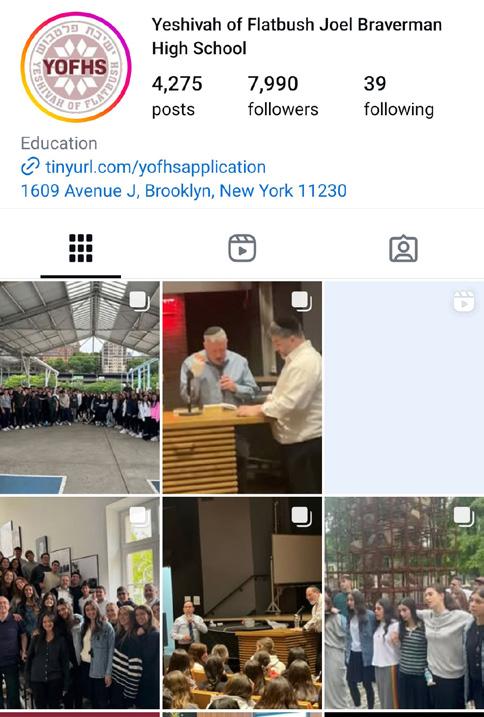
Unfortunately for those not looking picture-ready, students do not have a choice to opt in or out of the pictures. Parents sign a media release form in their children’s contracts which allows the school to post pictures of students on their social media platforms.
Marketing coordinator Ms. Michelle Kopylov runs the school’s social media platforms and creates content. At any major or minor school event or gathering, Ms. Kopylov is present and taking photos. Despite not needing students’ direct consent, Ms. Kopylov said that she tries her hardest to ask students before taking pictures but ultimately “the asking is just a courtesy.” She also emphasized that she carefully reviews all photos before she
posts them and tries to avoid posting students caught making an unflattering face to prevent any embarrassment. “I even crop people out and really try to make sure I’m posting everyone looking their best,” she shared.
Even with these efforts taken, many have resorted to hiding their faces at the sight of the camera and avoiding the shot in creative ways. Some put books in front of their face or go for a simple hand cover. Others duck behind a friend, switch seats, or leave the room entirely. The options are truly endless. However, senior Morris Ringer confessed that “getting in the pictures is unavoidable so I try my best to look nonchalant at all times just in case I’m in the background of a shot.”
Some do not mind being featured when they pose for pictures and expect to see themselves. “It’s just weird when I didn’t see her taking a picture and I see myself on the Instagram that night, but if she asks me to smile it’s OK for her to post it,” senior Ricky Haddad said.
One thing most students agree on is that they follow the school’s social media accounts and enjoy most of the posts—as long as they are not the ones in the photos.
Physics has rocky first year
continued from front page negatively impacts students who struggle with math. The course is very math based and many students’ math skills are not up to par. Some students, especially the struggling students, voiced their concerns that physics will hurt their averages and prevent them from getting into college, especially CUNYs. “It’s an unnecessary course. If it’s not a college course that is absolutely required, then students should be able to choose a class that they are actually interested in taking,” said junior Frieda Cohen.
As this new policy is implemented,
both students and teachers are navigating the changes and adapting to the updated curriculum.
Ms. Terzi, one of the physics teachers, says that her goal in teaching physics is to make the students fascinated and intrigued on how the world works. “Physics is involved in everything that we do,” she explained. “Relating the topics to their everyday lives really was very helpful and kept it interesting. One of the students’ favorite projects that they had was creating their own new sport and using Newton’s Laws to explain it.”
AP science students must join science clubs
By Olivia Shamayeva Junior Editor
Starting next year, students enrolled in AP Biology, AP Chemistry, and AP Physics 1 will be expected to do more than keep up with classwork. In addition to the usual summer homework, the science department is now mandating participation in a science-related extracurricular activity. These include the Jerusalem Science Contest Tsei U’lemad, Science Olympiad, or Medical Research Club.
This change stems from ongoing challenges the department has faced with student participation in extracurriculars. Science Department Chair Ms. Freedman explained, “For quite some time now we’ve been having difficulty having students sign up and maintain their momentum throughout our semester and year long rigorous science clubs.” She noted that “the Science Olympiad competition team always took a hard hit with a very low sign-up rate and even lower retention rate,” adding that there was similarly “poor attendance for our clubs and Tsei U’lemads that demanded the extra rigor of research or writing.”
Ms. Freedman further emphasized that students who aim for competitive science-focused colleges are often falling short—not from their coursework, but due to their “lack of research and experience beyond the classroom environment.” She stressed that, “too often, students do not appreciate these extra opportunities and resources which are really quite essential to their growth as students of the sciences.”
Despite the department’s intentions, the new rule has sparked mixed reactions
among students. An anonymous sophomore expressed that she doesn’t believe it should be required to take a science extracurricular on top of the course. “We are already taking this incredibly time-consuming and difficult class along with so many other classes and extra things to focus on,” she said. Arguing that participation in science extracurricular shouldn’t be mandatory, she suggested that instead “a satisfactory GPA, like for any other AP class, should be enough.”
Junior Joy Harari stated, “It’s great to encourage more student involvement in extracurriculars, and hopefully it will be enjoyable and beneficial for everyone in these clubs.” However, she pointed out that, “I am just hoping it won’t feel like too much work, especially with other schoolwork and the AP itself.”
Teachers have also been weighing in on the change. AP Physics teacher Dr. Shahar shared that while he doesn’t have particularly strong feelings about the new requirement, he believes it can assist in the seriousness of the AP science electives. “Depending on what extracurriculars students choose, this could be very helpful for students,” he said, adding that activities which promote different ways of thinking can “complement AP sciences nicely.”
This new requirement is the department’s effort to better prepare students for success in both their academics and future careers. As Ms. Freedman stated, the ultimate goal is to maximize student experience and foster a “strong, well-rounded, curious, and competent science student who will capably and confidently excel in their chosen field of study.”
SAT less ‘optional’ than many students think
By Leslie Mishaan Contributing Writer
In recent years, the role of the SAT in college admissions has shifted dramatically. With many schools adopting test-optional policies, the Class of 2025 was faced with a complex decision: whether they should submit their SAT scores to colleges.
According to data from this year’s senior class, about 30% of students submitted SAT scores to at least one college. Their college lists varied widely, from SUNY Binghamton and CUNY’s Brooklyn College to hyper-competitive programs like NYU, Columbia, and the Brooklyn BA/ MD program. Even students who were overqualified for certain schools still sub-
mitted scores because a strong SAT score can help earn merit scholarships or offset weaker parts of an application.
Most submitted scores fell in the 1200 to 1560 range. For students with lower GPAs, a 1200+ SAT score made schools like Brooklyn College more attainable. However, scores below 1200 didn’t help much, especially at competitive or specialized programs.
Roughly 10-15 students submitted scores of 1400 or higher, mainly targeting highly selective or Ivy League colleges. While it’s unclear how much submitting helped them, not submitting scores can sometimes be a disadvantage - particularly at STEM-heavy schools or business programs, where colleges expect to see strong quantitative indicators.
In fact, students applying to engineering or medical programs (like Columbia Engineering or the Brooklyn BA/MD) may have hurt their chances by withholding scores. These fields often expect applicants to demonstrate academic strength with data, especially when comparing against peers with perfect 5s on AP exams and 1500+ SATs.
For the Class of 2026, several top schools are reinstating SAT/ACT requirements, including Harvard, Yale, MIT, Brown, Dartmouth, and Georgetown. Public universities in Florida never removed the testing requirement. Looking ahead, the Class of 2026 will see additional schools like Cornell, Penn, and Stanford return to test-required policies.
This shift is a reminder that test-op-
tional doesn’t mean test-irrelevant. When scores are left out, everything else becomes more important—the rigor of your courses, grade trends, honors, extracurriculars, teacher recommendations, and essays. For some, especially strong students who struggle with standardized testing, this flexibility can be a relief. But for many, especially those applying to selective programs, a good SAT score can still provide a competitive edge.
The SAT isn’t everything, but in many cases, it still matters—especially for students pursuing business, engineering, or other competitive fields. With more colleges reinstating testing requirements, it’s important to be ready and informed on the new college admissions process.
Yeshivah of Flatbush regularly celebrates the students who excel in the classroom and on our many teams. But many Flatbush students’ most impresive accomplishmnets occur beyond school’s walls. In this special feature we shine a spotlight on 18 Flatbush students who are achieving remarkable things in a variety of fields and activities outside of school.
By Raquel Gindi and Katie Hidary Senior Editors

David Dweck, 12th Grade, Fashion
“In the summer going into junior year, I came up with the idea for my sweatshirt business, but I was very busy. When senior year came around I decided to give it a shot. My signature hoodie features a crotchet motif. Now whenever I get a chance, I’m always making hoodies, working on the website, or delivering my products. It is so rewarding to see people wearing my designs and handcrafted sweatshirts.” @crochet_cbh
Leslie Mishaan, 11th Grade, Science
“I spent two months working on a research paper about how gold nanoparticles can help in cancer treatment. Doing this project helped me realize that I want to do something in the medical field, especially something more hands-on, like surgery. I submitted my research to a research competition called the Jerusalem Science Competition.”

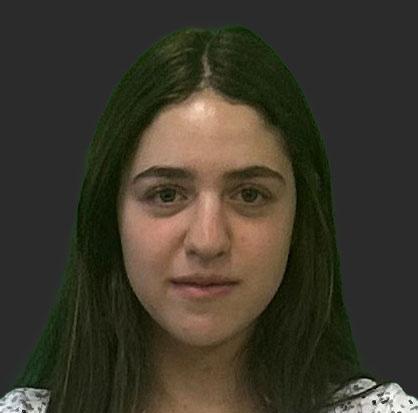
Mark Levy, 12th Grade, Music
“I started my DJ career at the end of my junior year to remember my brother Jack, who loved music and inspired me to love it, too. I bought a DJ board and kept going, and I had times where I thought it was all a waste of time and wanted to quit. His advice to push forward and ‘believe it to see it’ pushed me to make it in the DJ world.”
Nathan Hasson and Eli Chehova, 12th and 11th Grade, Food
“Mama Shawarma is a unique Middle Eastern style catering business, where we make all of our food fresh on-site. We cater all types of events and semachot. I started this along with my cousin, Eli Chehova, after an idea that sparked at the 2024 YOF Annual Auction.”
Rami Harari, 11th Grade, Sports
“I got into biking during COVID, riding with my dad, and a year later I picked it up again and never stopped. I’ve cycled 100 miles in one ride, biked 1,800 miles in one year, and I’ve biked in eight states and two countries. I love the thrill, the rush of fresh air, and the freedom I feel every time I ride. It’s like escaping the real world and entering my own zone. In the future, I want to keep biking consistently, get better gear, ride more with others, and inspire people to enjoy it too.”
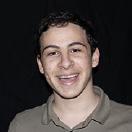
18 18
Francine Massry, 11th Grade, Music
“I taught myself piano in freshman year, and in my sophomore year I became interested in how music was put together. I wanted to challenge myself and see if I could make my own song. Since then I have made three original nonlyrical songs, with many more to come.” Massry recently performed one of her original piano compositions at Evening of the Arts.
Joey Esses, 11th Grade, Sports

“I am the founder of Allstars Basketball Training Clinic. I’ve been playing basketball all my life and have always had the idea of training other kids to make some money. During Pesach of my sophomore year I was home and decided to really try to build something. I made an Instagram account, but it wasn’t making any progress. I got my mom’s friends to let me teach her son, and from there it spread through word of mouth and my Instagram started becoming more active. The kids loved the sessions while also improving their basketball skills. My goal is to provide enjoyable and also intense training sessions to kids to help improve their basketball skill and improve their confidence. I’ve worked with many kids in the past year and plan to continue to upscale in the future.”
Savannah Betesh, 9th Grade, Sports
Dance has been a part of my life since I was three years old, evolving from a childhood hobby into a true passion that fuels my self-expression. Over the years, competitive dancing has taught me the thrill of telling a story through movement when struggling to communicate with words.
Ilana Kroub, 11th Grade, Photography
“I’m the official photographer for the Flatbush Falcons. My business first started with a viral video of a dunk that appeared on ESPN Sportscenter. Ever since then, I have been passionate about photography and videography, particularly sports photography. I love capturing memories and action, knowing that it all is from the power of just one click! I plan to pursue my love for photography in the future.”
Celia Jajati, 12th Grade, Fashion
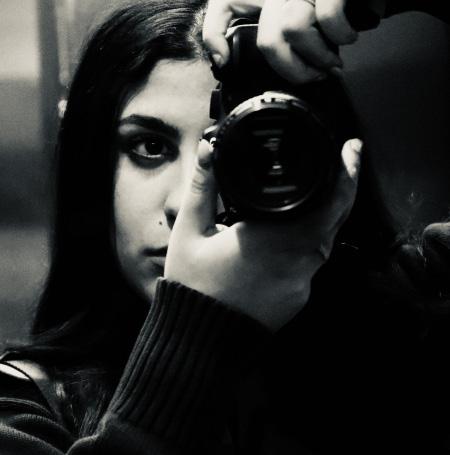
“I’ve always had a passion for hairstyling, and after years of friends and family encouraging me to pursue it professionally, I started my own hair business this past November. I plan to go to cosmetology school to continue this passion of mine and learn more.”
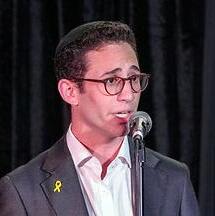
Daniel Hafif, 11th Grade, Music
"I work as a hazzan and sing at weddings — it started with school performances and small gigs, and grew from there as people started asking me to sing at their semahot. Now it’s something I genuinely love doing, bringing good energy and music to meaningful moments.”
Rita Setton, 10th Grade, Art
“A few months ago, I was inspired to start a needlepointing business because of my mom. She loves to needlepoint but she had never done anything with that love, so we decided that we were going to make a business together! I love that needlepointing is so calming and relaxing. It helps me focus my head while my hands are busy.” @do_it_right_stitches
Sarah Soussan, 11th Grade, Photography
“One day, I saw a show being filmed in the city, and in that moment, I knew I wanted to be part of that world. I started taking pictures in school and I eventually started getting hired for different jobs. Balancing this passion with school hasn’t been easy. I want to pursue my passion for photography in college and turn what started as a hobby into a career.” @ssphotography.57
Rebekah Chichester, 12th Grade, Science
“When I decided that I wanted to pursue a job in pharmaceuticals, Pathfinders found me the perfect internship at a pharmacy to see if it really was the right fit for me. After two years of working in the field, I’m happy to say that it has been such an incredible experience that has supported my decision to study to become a pharmacist.”
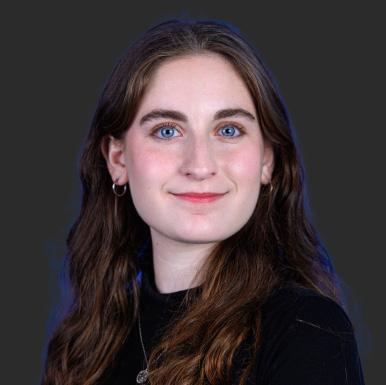
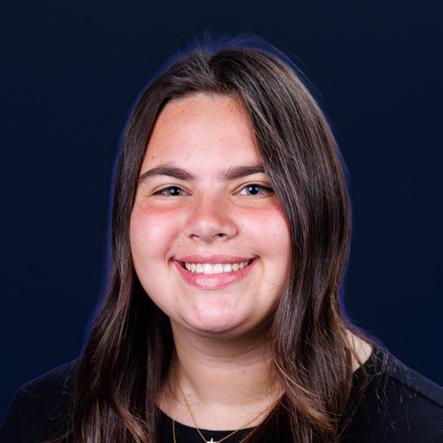
Charlotte Assoulin, 12th Grade, Camp
“Last summer I started my own post-camp. I saw how many parents struggled to entertain their kids the two weeks after camp. I made an Instagram account (@assoulinpostcamp), hired staff, made lunch, and planned activities such as baking, art swimming and had every sport available for the kids to play. This upcoming summer I plan on doing pre- and post-camp!”
Sylvia Habert, 12th Grade, Art
“I always had a passion for art and painting. This past January I was asked to start an art class for a group of young girls. Each week they continue to work on a painting project, while being assisted by my advice and guidance. I plan to continue doing this in the future and am planning to pursue my passion for fine arts in college.”
Rachel Sitt, 11th Grade, Fashion
“I started my hair business this past year by posting my friends’ hair that I styled. By doing this, people began to book me and I got more well known. This changed my outlook on what I want to do in the future and now I’m considering going to cosmetology school.”
Michelle Saadia, 12th Grade, Science
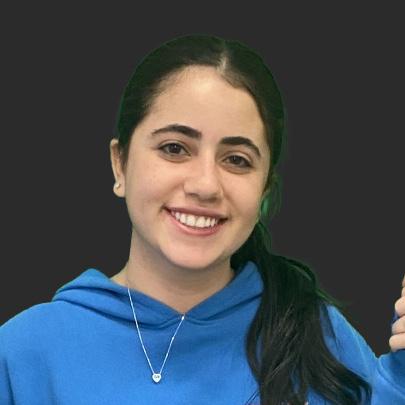
“This past July, I had the opportunity to shadow a pediatric surgeon at Maimonides Medical Center. I spent time both in the office, observing patient interactions, and in the operating room, witnessing surgeries firsthand. The experience required early mornings and late nights, but I was fully engaged every step of the way. It affirmed my desire to pursue this path and made me more certain than ever that this is what I want to do for the rest of my life.”
Sportsman Spotlight: Louie Franco tops off championship with MVP Sports
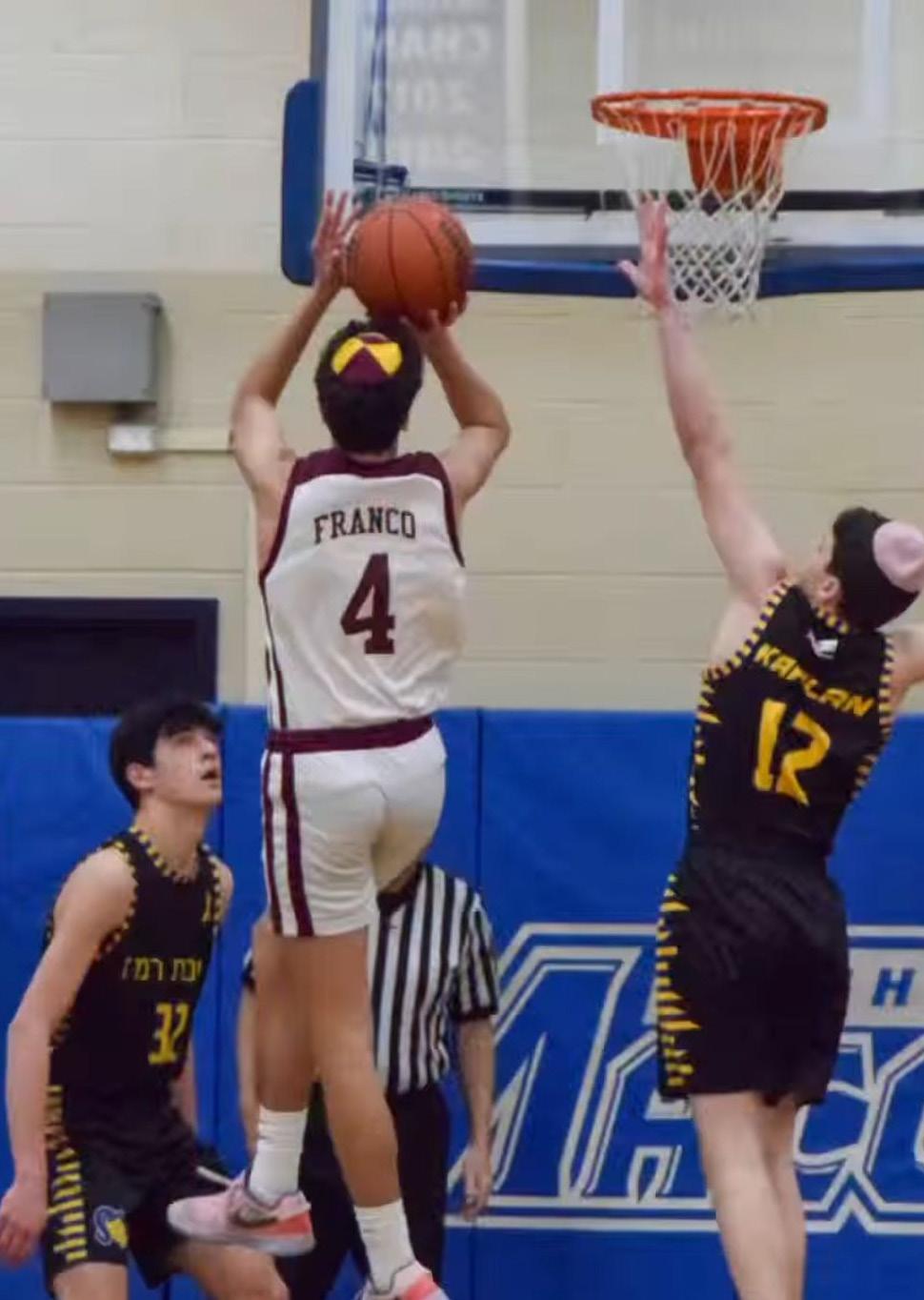
By Elliot Cohen
Junior Editor
When the Flatbush Falcons JV Basketball team took home the championship, beating Ramaz in an overtime thriller, the MVP was awarded to Louie Franco, who came through in the clutch for the Falcons, icing the game with a free throw. Franco talked about the treacherous preparation that went into this season. “There’s a lot that goes into preparation for every game,” Franco said. “Film sessions
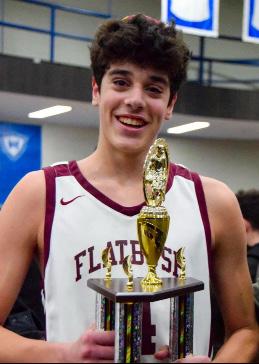
in the brand new film room, drawing up plays fit for the matchup of that game, and relentless effort from everyone on the team every single night during practice.”
During the season, the Falcons lost access to their nest, the Triangle Capital Gymnasium. Franco said that the Falcons refused to let that setback stop them. He credits Center Sports Director Harry Chazanoff with letting Flatbush utilize the Center’s gym for games and practices throughout the season.
Franco knows the importance of lock-
Girls soccer team gets cut
By Vera Esses Contributing Writer
Last spring, there was an active girl’s soccer team, but this year the team is no longer running. The head of the athletics department, Adam Ginsburg, explained that, because of a lack of interest from the girls, the team will not exist at all this year.
“This was a very disappointing decision for us, but starting last spring we noticed there was a declining interest in the girls soccer team,” Coach Ginsburg said. He added that during last spring the team had a couple of meetings to discuss this year, and the commitment that each girl would need to make in order to be a part of the team. Last spring the team even had to forfeit some games because they didn’t have enough players. They had about five committed girls who would show up to all games and practices, but around ten other girls who were unreliable, leaving their teammates to suffer the consequences.
Going into this year they wanted to try
ing in before a big game. While he admits that it was not always easy, Franco credits his friends, family, and teammates. “They helped me understand what was at stake and what a successful job would feel like.”
Although the game was a true thriller, Franco said that his favorite moment was when he hit a pivotal three to put Flatbush up by one with a minute left. He explained that the shot, the crowd, and his emotions made for an incredible end to the game. This three was truly clutch, becoming the go-ahead point in the nailbiter matchup.
to solve that problem by having multiple interest meetings, but had an exceptionally low number of students show up. They also had two different tryouts but those drew only around ten students, which is not a strong enough interest to have a team.
One of last year’s captains, Sarah Soussan, spoke about how last year’s soccer team faced many injuries and lack of dedication which was represented on the field. She said, “One of the difficulties I faced was when I fractured my toe in the beginning of the season and wasn’t able to play for four games. In addition to that, towards the end of the season I was in a boot and wasn’t able to be on the field for two games. During this time I realized how much I look forward to soccer and how much love I had for the game. Even though there wasn’t a team this year, the sports community here at Flatbush hopes there will be one next year, to strengthen school spirit and lead the school to victory.”
Afterward, the feeling was surreal for Franco. Being his first time winning something this big, he said that it was “definitely a top moment” in his life, and that nothing could have prepared him for that feeling.
When asked what his message was to anyone that was thinking about trying out for the team next year, he responded with one simple word.
“Grind.”
Midwest devastated by destructive tornadoes
By Victor Shemia World News Editor
Due to severe weather since May 15, the midwest has been terrorized by a string of tornadoes in the region, leaving towns in ruins and changing lives forever.
Although tornadoes are common in the midwest, this season has been especially devastating. Northern Texas, Oklahoma, Arkansas, Kansas, Kentucky, and Missouri have been affected by Ef2 and Ef3-level tornadoes, which include winds from 111 to a whopping 135 miles per hour. These areas, known as “Tornado Alley” for the common recurrence of tornadoes, have been affected by the peak of a brutal tornado season, which usually occurs between April and June.
Thousands have lost their homes from the destructive nature of these tornadoes, and it doesn’t seem to be ceasing just yet. The damages are quite costly, with the estimates ranging from $9-11 billion. Kentucky in particular seemed to receive the brunt of the storm patterns and has the highest death toll of all the states affected (19 deaths in Kentucky out of the 28 total). The majority of deaths occurred in Laurel County, which is currently unrecognizable as hundreds of homes are destroyed.
Along with this, Missouri has also been decimated by tornadoes, as at least seven people have been confirmed dead and nearly 5,000 buildings have been demolished. In Oklahoma, Arkansas, Missouri and Kansas, more than 140,000 homes have lost power, leaving people
helpless and fearful of what’s to come.
Local authorities are currently overwhelmed by the surge in recovery efforts and emergencies, calling for federal aid to assist them. In response, the federal government issued a “primary focus” onto the states. This, along with efforts by the government to shift disaster recovery to the states, worsens the issue, as cities receive less federal assistance. With states being in charge of looking over themselves, the federal government will be providing aid only if it has been “deemed necessary.” This has brought about fear and concern among experts, as most recovery and emergency units have been recently lacking the proper funds to carry out such expansive efforts.
Experts are warning locals to brace for more in the upcoming weeks. Hail the size of tennis balls, extreme heat, strong winds, flooding, and even more tornadoes are all on the table for the coming days, causing rightful dismay to those in the affected regions. This series of abnormally extreme weather is only the beginning to a worrying prediction for the rest of the year, as nine hurricanes and seventeen named storms may be on the way when hurricane season hits at the end of the summer.
The only precautions that could be taken by those in the affected area are either temporary relocation, or moving to a safe space. As of now, curfews are in place and warnings sound throughout the day, sometimes hundreds over the span of a couple hours. Currently, supply efforts are underway, as people are stranded without basic necessities.








Science in English Danger blooms as toxic algae poisons sea life
By Victor Shemia World News Editor
A simple trip to the beach has turned hazardous, as many tourists and locals alike from across the globe have reported seeing varying species of sea life washed up on the shore. With tallies reaching the hundreds, many attribute this to being more than just a simple anomaly. Yet, the culprit behind such a strange sequence of events is rather unsuspecting, as scientists attribute this to a species of poisonous algae, which had an unprecedented uptick in growth in recent months.
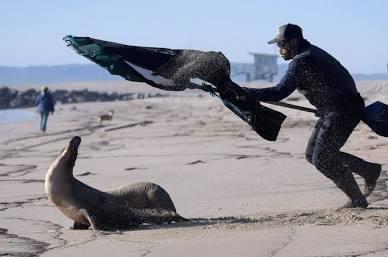
training session. Upon investigation, both sea lion attacks have been concluded to be a result of domoic acid poisoning.
Occurring since February, massive swarms of a toxic algae named “pseudo-nitzschia” has been taking over areas where vital ecosystems usually flourish, leading to the deaths of many endangered species. Although this malicious species of algae has been a frequent issue since the 1980s, it has recently become abnormally aggressive, leading to severe consequences to marine life.
Pseudo-nitzschia releases a neurotoxin called domoic acid, which primarily travels through the food chain. Though the symptoms vary depending on the amount of the toxin that is ingested. They include extremely erratic behavior, foaming from the mouth, seizures, and even death. The toxin is harmful to a wide array of marine life, including most species of fish, sharks, and whales.
Some unfortunate beachgoers have witnessed the terrifying poisoning firsthand, with a few even becoming victims of it themselves. Two attacks were reported in March alone on California’s shores, where “demonic” sea lions have displayed vicious behavior. One vicitim was a surfer who was bitten and dragged off his surfboard, while the other was a 15-year-old girl who was swimming during a lifeguard
Although many beaches have been victims of toxic algae, it seems that Australia and California have suffered the brunt of it. In California, a shocking number of sea lions and dolphins have been affected or killed by the algae. Dolphins in particular have a much higher mortality rate than other species of marine life, as they ingest the highest amount of the toxin through their diet. Dolphins mainly eat sardines, who are known to contain a high dosage of the toxin. Beaches in Australia have suffered from heavy concentrations of the algae, which is so large that it has surpassed 3,400 sq miles in size. This heavy presence is not only toxic, but invasive, as the algae quite literally sucks the oxygen out of the neighboring areas of water, leading to sea animals literally suffocating to death.
The reason behind the sudden boom in algae growth is suspected to be from a sudden rise in temperatures in typically colder months such as February, which has given the chance for the algae to populate from an earlier time than usual. This, along with a 2.5 degree rise in temperature in general, has led to an overall increase in algae growth.
The toxin is generally not directly deadly to humans. The worst reactions to the acid among humans were mild at best, with skin irritation and some discomfort being the worst of it.
College Guidance takes sophomores to visit college campuses
continued from front page (ED) and applying ED is a big decision that you want time to think about.”
While a few juniors got to join the sophomore trip to Barnard due to extra spots, the rest of the juniors have not been taken by Flatbush on trips to visit any college. Many juniors are upset by that and feel unprepared. At this point, most colleges’ tours are filled up, leaving juniors to make application decisions without physically seeing colleges unless they schedule visits over the summer.
Junior Lizette Husney said, “So many of the places that I want to visit don’t have any more room left on their tours.” Junior Rachel Shamolian expressed her disappointment and said, “With tests, homework, finals, SATs and APs all piling up on us, it shouldn’t be on us to find the time to visit colleges. The school should provide opportunities. If they can do it for the
sophomores, it can and must be done for the juniors as well.”
Ms. Mottahedeh emphasized the difference between the trips the sophomores were taking and the visits the juniors should be taking. She said, “When students enter their junior year, the YOF College Guidance Department and YOF School Administration encourage families to start visiting colleges together—by then, students typically have a clearer academic profile.” Unlike the sophomores, juniors aren’t visiting it to get a peek into college life; they are visiting the specific schools that they are interested in to get a better and closer look.
Despite the complaints of juniors, the sophomore college visits were a huge success for sophomores, giving them insight on campus life in New York as a Jew.
Actress to royalty to influencer: Markle transitions again
By Lyla Ashkenazie
Sophomore Editor
Meghan Markle, former American actress, former British royal, and now influencer, rose to fame in 2011, where she was first noticed for her role as Rachel Zane in the hit TV series Suits. When she first married Prince Harry, Markle concluded her years of acting and shut down all her social media accounts in order to be a part of the British royal family. Now, Markle has become quite the creator. After taking leave from the British Royal Family, Markle has tapped into the world of social media.
She is now selling clothes and beauty products through Instagram, despite the fact that she says she isn’t an influencer. Markle is reportedly making millions of dollars by selling her products on social media. She also gets commission from sales of other companies’ clothing, and promotes the clothes by wearing them.
This type of advertisement and business is one used by many influencers and TikTokers, so it confuses many as to why
Markle is so hesitant to call herself an influencer. She instead calls herself an “entrepreneur,” or a “female founder.” Markle continues to spread positive messages through her new podcast, “Confessions of a Female Founder,” and her new cooking show, now streaming on Netflix, “With Love, Meghan.” The show has gained attention, especially after some cooks expressed skepticism about a few of her recipes. However, the feedback has been mostly positive, and the show is gaining traction across various platforms.
At least part of the inspiration for Markle’s new career seems to be financial. Since Prince Harry and his family have distanced themselves from each other, he and Markle are no longer financially supported by the family or by the British government. Prince Harry’s recent memoir and Markle’s efforts on social media have made up some of the difference.
While it is unknown if Markle is pursuing these endeavors as mere hobbies or as a full time job, it is clear that much of the internet is glad to be hearing from her again.

Ask Merle
Merle,
My dad’s mad at me because I keep spending so much at Crawford’s, but what can I do? I literally cannot live without paninis.
-Paninilover

Dear Paninilover,
You mean the $15 panini? In this economy? Girl, go to 7-Eleven. Or better yet, the Chanis- better food for a fraction of the price. (This letter was not sponsored by 7-Eleven or the Chanis).
Merle,
How does my teacher always announce a pop quiz right when I’m about to leave early?
-Bunbury
Bunbury,
It’s called karma. And teachers have a sixth sense for detecting when a student is about to pull a disappearing act. Either commit harder to your act and take the -10 points, or take the L and stay in school.
Too bad so sad,
Merle
Merle,
How do I study for Regents? I’m a freshman and I’ve never taken a test like this before. I’m so stressed!
-Freshie
Hi Freshie, I totally understand being stressed, and your first Regents exams are understandably frightening! But the best way to study is to begin reviewing at least a week before the exam, and taking practice tests. The way to ensure you are prepared for whatever questions they throw at you is to practice as many times as you can!
Good luck!
Merle,
What should I do this summer?
-Stressed
Stressed,
Despite hit shows, Apple TV+ lags behind

By Avital Rokhkind Contributing Writer
Apple TV+ has been gaining popularity since releasing viral shows Severance and Ted Lasso. Some speculate that Apple TV+ might become the primary—or even exclusive—streaming platform for many households in the near future.
Although Apple TV+ is not currently the leading platform in the streaming industry, several factors point to a potential shift toward greater reliance on Apple TV+ in the future. Apple TV+ offers a smooth, efficient streaming experience, with fast performance and quick app launches. Furthermore, Apple’s focus on creating a connected ecosystem across its devices and apps may encourage more users to make Apple TV+ their main streaming platform.
However, despite these factors, critics say it is unlikely for Apple TV+ to become a primary streaming hub. Its rising popularity is mostly tied to a few standout shows, rather than a broad, consistent content library. While Apple TV+ has many quality originals, it does not have the wide range of content that other services, such as Netflix, provide. Additionally, Apple TV+ tends to focus more on content aimed at older audiences, which has attracted a following among Millennials and Gen X viewers. In contrast,
Um, I think that’s a question for Pathfinders, not me. But some popular options are working in a camp, getting an internship, or being a mother’s helper. Personally I’ve only ever done the counselor thing; it’s a little annoying, but it’s fun if you do it with friends!
Merle, I have more residencies to make up than days of school are left. What should I do?
-Senioritis
Dear Senioritis, Is building a time machine and making it to minyan on time an option? No? OK, well, the only thing I can tell you is you must take every chance at residency you get, be in school 7:45 every day, and go to every speaker Rabbi Sklarin emails us about. It’s tough but there’s a reason you
platforms like Disney+ and Netflix offer a much broader range of programming, especially for kids and families.
At Yeshivah of Flatbush, responses mimicked those sentiments, with members of the faculty much more likely than students to use the service. Faculty like Ms. Doris Anteby of Pathfinders and English teacher Ms. Marcus are fans of the service. “Apple TV’s programming has a higher quality than other platforms,” expressed Ms. Anteby. Ms. Marcus agreed: “I think Apple TV’s programming they make themselves has a higher quality than other platforms, but it is true that they have limited content. Netfilx and Prime have so much, but a lot of their offerings are terrible quality.” However, few students claimed to watch Apple due to a lack of programming that appeals to high school students.
Limited content and a limited audience are proving to be significant obstacles. As a result, Apple TV+ still struggles to match the viewership numbers of its competitors. A couple of hit shows alone are not enough to overcome these limitations or allow Apple TV+ to compete at the same level as more established platforms. Despite these challenges, Apple has yet to announce any clear strategy for promoting Apple TV+ or boosting its popularity. It currently has no specific plans for Apple TV+.
don’t see me doing all of this… I come on time.
Sorry! Merle
Merle!
Now that you’re graduating will you tell us who you are?!
-Curious
Who am I? That’s one secret I’ll never tell… you know you love me.
XOXO, Merle
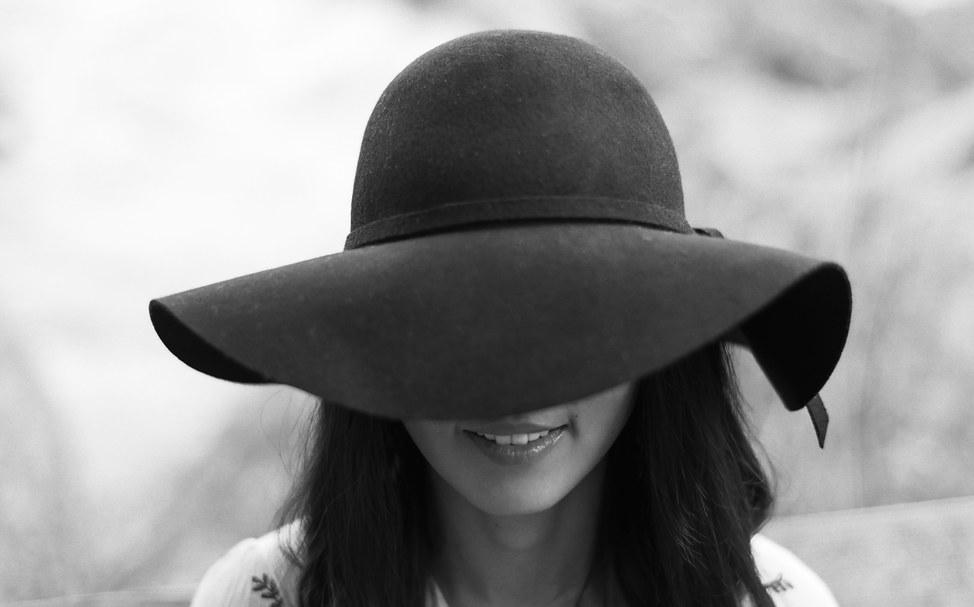
Standard of Fabulous
Tariffs devastate fashion world H&M replaces models with AI

By Emily Tarrab Business Editor
The fashion industry has been left in confusion and anxiety following President Trump’s intense tariffs on China— the largest exporter of clothing to the U.S.—as well as other dominant European countries that heavily contribute to both luxury fashion and U.S. made clothing. On April 9, Trump unleashed a harsh 145% tariff on Chinese goods, a striking 111% higher than what was initially threatened. As for all other countries, a 10% reprieve was granted for not imposing retaliatory tariffs, which was thankfully a huge relief. These tariffs have rattled the U.S. garment industry particularly hard. Only 2% of the clothing Americans buy is entirely American-made, and half of that is produced exclusively for the military. Most other garments labeled “Made in the USA” don’t count toward that 2%, as they still rely on imported fabrics such as goose down from Switzerland and Thailand, linen from France that was dyed in Portugal, and the list goes on. Shifting production fully to the U.S. is nearly impossible; growing and processing many fabrics domestically would take decades, and recruiting and training a large enough workforce is equally as daunting. With no viable way to localize production, companies are forced to raise prices, only to see demand drop as consumers face rising costs in every sector of commerce. In his effort to support American manufacturers, Trump has inadvertently pushed more shoppers toward cheaper secondhand clothing, which has accounted for approximately one-third of all clothing purchased in the US over the past year. On top of that, US based fashion companies have ordered products months in advance that are still overseas, now subject to higher tariffs than anticipated. These recent shifts have left small U.S. garment businesses and factories in disarray, placing a significant strain on their cash flow.
Larger American brands have already seen stock prices dip; Steve Madden is down 30% since Trump’s April 2nd tariff announcement, due to most of its products being manufactured in China. Similarly, Lululemon’s stock has nearly dropped 12%, with the company’s supply chain rooted in China, Cambodia, and Indonesia—three major global garment producers.

These chaotic tariffs and executive orders have also shut down what’s known as the “de minimis” loophole, which fast fashion outlets like Shein and Temu have long taken advantage of. The rule previously allowed small shipments under $800 to enter the US duty-free. For the average American consumer, who relies on cheap fast fashion to keep up with quick-moving trends and stay on budget, they will no longer face this comfortable reality, as both companies have announced plans to raise prices. (Shein raised prices 337%, according to Bloomberg.) A study published by the National Bureau of Economic Research has even concluded that, as a result, Americans might pay up to $13 billion more for said “de minimis” purchases each year.
As for luxury brands, the effects tariffs have on that sector may seem less detrimental, since they have larger profit margins and their consumers can more easily absorb higher costs, thus limiting economic pressure. Nevertheless, many luxe brands still manufacture in Asia, and the dizzying effects have been felt. Burberry stock, for example, dropped 10% following the tariff, after already tumbling 70% over the past 12 months. Anxiety continues to reverberate through the luxe fashion community, especially as many had turned to the US in recent years to bolster sales amid slowing business elsewhere.
It’s no surprise that President Trump’s tariffs are infiltrating every step of garment development. A ripple of uneasy effects will continue to surface for both the American seller and buyer.
By Rachael Kopylov Fashion Editor
Fashion retail brand H&M recently announced that it would begin using AI clones for social media and marketing campaigns, planning to create 30 “digital twins” of its models this year.
The brand claims that it will not change its “human-centric approach,” but many fear that this change will have dire unintended consequences. Despite the fact that models will still be paid for the use of their “clones,” other parts of the modelling industry could be affected, including hair, makeup, lights, and photographers.
twins” in similar ways to their current arrangements, with a fee negotiated by their agents. Models would also retain rights over their AI versions.

The news was received poorly by the wider industry, which fears that this could be the beginning of an unwanted AI revolution. It mirrors the concerns of Hollywood workers who went on strike in 2023 over the use of AI in television. A survey found that 54% of those who work at Bectu, the union that represents the creative industries, believe that AI will have a negative impact on the fashion industry.
H&M stated that models would be compensated for the use of their “digital
High profile H&M models such as Vilma Sjöberg and Mathilda Gvarliani, who also model for Vogue and high-end brands including Chanel, will likely be compensated extremely well. Many are excited for this change since it will allow models to take on more work and avoid traveling. “She’s like me, without the jet-lag,” said Gvarliani. However, AI has a high chance of threatening lower-tier models who appear on brands’ websites to showcase products. “Most models have had to deal with job loss already and this is a whole other frightening thing for them,” said casting agent Chloe Rosolek.
Other brands have already been experimenting with AI technologies. Denim company, Levi Strauss & Co, announced in March 2023 that it would use AI- generated models to “supplement human models.” Other fashion brands like Hugo Boss and Mango have also begun exploring the technology.
Men focusing on skincare
By Olivia Shamah Junior Editor
For years skincare has been considered a women’s industry, but it recently shifted to include men in its clientele.
Often lumped together with makeup and other beauty products, skincare has historically been marketed toward women, with products promising to deliver glowing or clear skin. However, as men have become more comfortable with the idea of self-care, the skincare industry expanded its customer base to include men as well.
Men’s skincare has always been a subcategory of specialized products, including those geared toward acne and other skin conditions, as well as over-the-counter products, like those from CeraVe and Cetaphil. On the other hand, higher quality or “luxury” skincare products from brands such as La Mer and Clinique have usually been reserved for women.
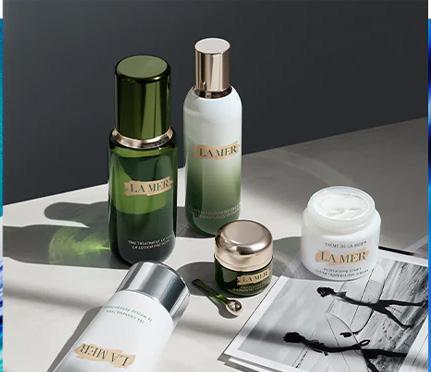
been catalyzed by social media and wellness influencers, many of whom advocated for better lifestyles for both men and women, which include habits like clean eating and work-life balance in addition to skincare practices. While these wellness and skincare influencers have traditionally been women, more and more male influencers are breaking through to audiences of men. Popular male influencers like AJ Brown and Ashton Barnes helped normalize men’s skincare and self-care.
In recent years, more men have been using skincare products and developing skincare routines. In fact, the industry has seen a 68% increase in its male consumers from 2022 to 2024, with over half of American men using premium skincare products today.
This shift in the skincare industry can mainly be attributed to changing attitudes towards masculinity and wellness, as more men are accepting self-care practices that were traditionally labeled as feminine, such as using skincare products.
The wellness revolution in general has
Because of this, men’s skincare has burst into the mainstream market, and products specifically formulated for men’s skin have been developed. Beauty giants like L’Oréal, Kiehl’s, and Dove have created men’s lines that overcome the feminine stigma around skincare with masculine imagery and taglines. Even male celebrities, like British actor Idris Elba, have created skincare brands mirroring those of female celebrities such as Hailey Bieber’s skincare brand Rhode Beauty.
